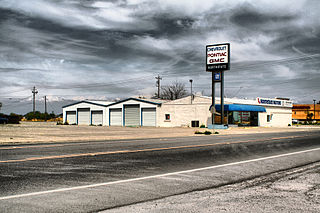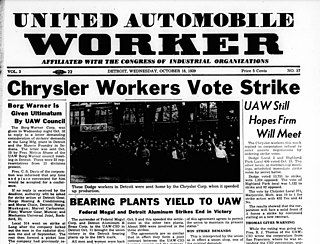Related Research Articles

Walter Philip Reuther was an American leader of organized labor and civil rights activist who built the United Automobile Workers (UAW) into one of the most progressive labor unions in American history. He saw labor movements not as narrow special interest groups but as instruments to advance social justice and human rights in democratic societies. He leveraged the UAW's resources and influence to advocate for workers' rights, civil rights, women's rights, universal health care, public education, affordable housing, environmental stewardship and nuclear nonproliferation around the world. He believed in Swedish-style social democracy and societal change through nonviolent civil disobedience. He cofounded the AFL-CIO in 1955 with George Meany. He survived two attempted assassinations, including one at home where he was struck by a 12-gauge shotgun blast fired through his kitchen window. He was the fourth and longest serving president of the UAW, serving from 1946 until his death in 1970.

The 1936–1937 Flint sit-down strike, also known as the General Motors sit-down strike, the great GM sit-down strike, and so on, was a sitdown strike at the General Motors plant in Flint, Michigan, United States. It changed the United Automobile Workers (UAW) from a collection of isolated local unions on the fringes of the industry into a major labor union, and led to the unionization of the domestic automobile industry.

The International Union, United Automobile, Aerospace and Agricultural Implement Workers of America, better known as the United Auto Workers (UAW), is an American labor union that represents workers in the United States and southern Ontario, Canada. It was founded as part of the Congress of Industrial Organizations (CIO) in the 1930s and grew rapidly from 1936 to the 1950s. The union played a major role in the liberal wing of the Democratic Party under the leadership of Walter Reuther. It was known for gaining high wages and pensions for auto workers, but it was unable to unionize auto plants built by foreign-based car makers in the South after the 1970s, and it went into a steady decline in membership; reasons for this included increased automation, decreased use of labor, movements of manufacturing, and increased globalization.

The National Automobile, Aerospace, Transportation and General Workers Union of Canada, commonly known as the Canadian Auto Workers (CAW), was one of Canada's largest labour unions. In 2013, it merged with the Communications, Energy and Paperworkers Union of Canada, forming a new union, Unifor. While rooted in Ontario's large auto plants of Windsor, Brampton, Oakville, St. Catharines, and Oshawa, the CAW has expanded and now incorporates workers in almost every sector of the economy. The presidents of the CAW were Bob White (1985-1992), Buzz Hargrove (1992-2008), Ken Lewenza (2008-2013), and Jerry Dias (2013–2022) when the CAW became UNIFOR.

Douglas Andrew Fraser was a Scottish - American union leader. He was president of the United Auto Workers from 1977 to 1983 and an adjunct professor of labor relations at Wayne State University for many years.

Roland Jay Thomas, also known as R. J. Thomas, was a left-wing leader of the United Auto Workers in the 1930s and 1940s. He grew up in eastern Ohio and attended the College of Wooster for two years. The need to help support his family caused him to leave college and go to work. In 1923, he moved to Detroit, where he worked in a number of automobile plants.
Owen Frederick Bieber was an American labor union activist. He was president of the United Auto Workers (UAW) from 1983 to 1995.
In the automotive industry, the term Big Three is used for a country's three largest motor vehicle manufacturers, especially indicating companies that sell under multiple brand names.
Nelson "Jack" Edwards (1917–1974) was Vice President of the UAW, and a founder of CBTU, the Coalition of Black Trade Unionists.
The 2007 General Motors Strike was a labor union strike that lasted three days from September 23 to September 25 of 2007 organized by the United Auto Workers (UAW) union. The UAW were engaged in talks with General Motors (GM) to negotiate a new labor contract but were unable to come to an agreement before the deadline. Consequently, 73,000 workers walked out forcing 80 GM facilities in 30 states to cease operations. After the two day strike, the two parties reached an agreement in which the UAW union would assume the responsibility for managing retiree healthcare liabilities. The UAW previously went on strike against General Motors in 1970.

Leon E. Bates Sr. was an American labor union leader with the United Auto Workers union (UAW) from 1937 to 1964 when he retired as an "International Representative" of the UAW. He was one of the first African-American union organizers to work for the "UAW-CIO".

Beginning in the later half of 2008, a global-scale recession adversely affected the economy of the United States. A combination of several years of declining automobile sales and scarce availability of credit led to a more widespread crisis in the United States auto industry in the years of 2008 and 2009.

Robert Thompson King is an American lawyer and labor union activist and leader. He was elected President of the United Auto Workers (UAW) on June 15, 2010. His term of office ended in June 2014, and King announced his retirement, being succeeded by Dennis Williams as head of the UAW.
Stephen Phillip Yokich was an American labor union activist who served as President of the United Auto Workers from 1994 to 2002.
The Canadian auto industry is closely linked to the U.S., due to the Automotive Products Trade Agreement and later the North American Free Trade Agreement (NAFTA), and is in similar trouble. Canada's 3,500 car dealers, which employ 140,000 people, told the federal and Ontario governments in mid-November they are at risk from the financial crisis; they are asking the national government to help out despite a record year of sales. Ottawa is considering providing financial aid to the Canadian subsidiaries of the Big Three, and possibly auto parts companies as well. The auto industry argued that loan guarantees and other help would try to save tens of thousands of Canadian jobs threatened by the sudden drop in North American car sales. Chrysler Canada has asked for $1 billion in aid, making it the only Canadian arm of the Big Three to make a specific dollar request.

Victor George Reuther was a prominent international labor organizer. He was one of three Reuther brothers who were lifelong members of the U.S. labor movement. His older brother Walter became the president of the United Auto Workers union (UAW) and Victor became the head of that union's Education Dept. and an organizer on the international level. He was a proponent of social democracy.
A master contract or master agreement is a collective bargaining agreement which covers all unionized worksites in an industry, market or company, and which establishes the terms and conditions of employment common to all workers in the industry, market or company.
The tool and die strike of 1939, also known as the "strategy strike", was an ultimately successful attempt by the United Auto Workers Union (UAW) to be recognized as the sole representative for General Motors workers. In addition to representation rights, the UAW, working jointly with the Congress of Industrial Organizations (CIO), sought to resolve existing grievances of skilled workers.
From November 21, 1945, to March 13, 1946, CIO's United Automobile Workers (UAW), organized "320,000 hourly workers" to form a nationwide strike against General Motors, workers used the tactic of the sit down strike. It was "the longest strike against a major manufacturer" that the UAW had yet seen, and it was also "the longest national GM strike in its history".

The Chrysler Auto Strike began in October 1939 at the Dodge Main Plant in Detroit, Michigan, as a struggle between the Chrysler Auto manufacturer and The International Union, United Automobile, Aerospace and Agricultural Implement Workers of America, better known as the United Auto Workers (UAW).
References
- ↑ seekingmichigan.org -Retrieved 2012-07-04
- ↑ Barnard, John (1983). Walter Reuther and the Rise of the Auto Workers . Boston: Little, Brown and Company. p. 102.
- ↑ Barnard, John (1983). Walter Reuther and the Rise of the Auto Workers . Boston: Little, Brown and Company. p. 103-108.
- ↑ Barnard, John (1983). Walter Reuther and the Rise of the Auto Workers . Boston: Little, Brown and Company. p. 138.
- ↑ Dayton, Eldorous (1958). Walter Reuther: The Autocrat of the Bargaining Table . New York: Devin-Adain Company. p. 178.
- ↑ Dayton, Eldorous (1958). Walter Reuther: The Autocrat of the Bargaining Table . New York: Devin-Adain Company. p. 179.
- ↑ Barnard, John (1983). Walter Reuther and the Rise of the Auto Workers . Boston: Little, Brown and Company. p. 141.
- ↑ Reuther, Victor (1976). The Brothers Reuther and the Story of UAW . Boston: Houghton Mifflin Company. p. 310. ISBN 9780395243046.
- ↑ Barnard, John (1983). Walter Reuther and the Rise of the Auto Workers . Boston: Little, Brown and Company. p. 143.
- ↑ Lichtenstein, Nelson (1995). The Most Dangerous Man in Detroit . New York: BasicBooks. p. 283. ISBN 9780465090808.
- ↑ Barnard, John (1983). Walter Reuther and the Rise of the Auto Workers . Boston: Little, Brown and Company. p. 140.
- ↑ Lichtenstein, Nelson (1995). The Most Dangerous Man in Detroit . New York: BasicBooks. p. 283. ISBN 9780465090808.
- ↑ Barnard, John (1983). Walter Reuther and the Rise of the Auto Workers . Boston: Little, Brown and Company. p. 140.
- ↑ Lichtenstein, Nelson (1995). The Most Dangerous Man in Detroit . New York: BasicBooks. p. 283-4. ISBN 9780465090808.
- ↑ Barnard, John (1983). Walter Reuther and the Rise of the Auto Workers . Boston: Little, Brown and Company. p. 142-143.
- ↑ Barnard, John (1983). Walter Reuther and the Rise of the Auto Workers . Boston: Little, Brown and Company. p. 154.